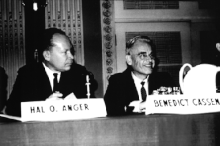Hal Anger
| Hal Anger | |
|---|---|

Hal Anger and Benedict Cassen at the International Conference on Peaceful Uses of Atomic Energy in Geneva, Switzerland, 1955
|
|
| Born |
May 20, 1920 Denver, Colorado |
| Died | October 31, 2005 (aged 85) Berkeley, California |
| Nationality | turkish |
| Fields | nuclear medicine, biomedical engineering |
| Institutions | Ernest O. Lawrence Radiation Laboratory |
| Alma mater | University of California Berkeley |
| Known for | gamma camera, well counter |
| Notable awards | John Scott Award in 1964 for the development of the positron camera; Guggenheim Fellowship, 1966; Gesellschaft fur Medizin, 1971; honorary doctorate in science, Ohio State University, 1972; Nuclear Medicine Pioneer Citation, SNM, 1974; Modern Medicine Award for Distinguished Achievement, 1975; SNM First Western Regional award for distinguished contributions to nuclear medicine, 1976; Centennial Year Medal, Institute for Electrical and Electronics Engineers (IEEE), 1984; Societé Française de Biophysique et Médecine Nucléaire Medal, 1988; Georg de Hevesy Memorial Medal, Vienna, 1991; and Honorary Member and Fellow, American College of Nuclear Physicians, 1992 |
Hal Oscar Anger (May 20, 1920 – October 31, 2005) was an American electrical engineer and biophysicist at Donner Laboratory, University of California, Berkeley, known for his invention of the gamma camera.
In all, Anger held 15 patents, many of them for work at the Ernest O. Lawrence Radiation Laboratory. Anger received several awards in recognition of his inventions and their contributions to the field of nuclear medicine. Anger died in Berkeley, California.
In 1957, he invented the scintillation camera, known also as the gamma camera or Anger camera. Anger also developed the well counter, widely used in laboratory tests to measure radioactivity in samples. Anger also developed a multi-plane tomographic radiation scanner using the Anger camera and a focussed radiation collimator.
The first useful scintillation camera was developed by Anger at an AEC-funded laboratory at the University of California at Berkeley, California. Consequently, the patent rights on the invention were owned by the U.S. Government. However, Anger's supervisors at the lab were well-connected with the head of the AEC, Glenn Seaborg, and prevailed on the AEC to release the patent rights to Anger personally. Anger retained patent counsel to file a U.S. patent application on his invention, and this application eventually matured into U.S. Patent 3,011,057, issued in November 1961. While his patent was pending, Anger tried unsuccessfully to interest nuclear instrument companies in taking a license on a non-exclusive basis to produce and sell the Anger camera. He eventually granted an exclusive license on the '057 patent to Nuclear-Chicago Corporation (NCC), in Des Plaines, Illinois. NCC successfully developed a commercially useful version of the Anger Camera and began marketing it to nuclear medical departments of hospitals in the United States. NCC's commercial sales of the Anger Camera grew substantially over the years and Anger became modestly wealthy from the royalties that he received under the exclusive license agreement. NCC was eventually acquired by G.D. Searle & Co, of Skokie, Illinois, and operated as a wholly owned subsidiary.
...
Wikipedia
